It’s something of a special treat to land a 4K package of five pristinely remastered, cleverly written, and well-acted films like those in the Criterion Collection‘s new six-disc box set Ranown Westerns: Five Films by Budd Boetticher Starring Randolph Scott. Even more special is the fact that these films, unlike most of the early spine numbers in the collection, are not the most well-known classics of the genre, but instead a lesser-known yet perfectly cohesive, fascinating collaboration of director and actor re-examining the genre just as it appeared headed towards a dead end.
In the late 1950s, the American Western film genre had been, for the better part of two decades or so—not unlike superhero cinema today—a complex, successful, and wide-ranging undertaking of national myth-making matched with box office success. Of course, it had been there since cinema’s inception, in Edwin S. Porter’s The Great American Train Robbery, and throughout the silent era in serials and B-movie “oaters,” but the genre came alive with the John Ford-John Wayne collaboration Stagecoach in 1939 and continued with commercial and critical success through the next two decades. The 1950s, in particular, saw both generic experimentation (Delmer Daves’ Jubal was essentially a technicolor melodrama; films The Furies like employed the tropes of film noir) and gender play (Forty Guns, Johnny Guitar), signaling a need to test and tweak the genre’s core tenets. Ford’s 1956 The Searchers was a film focused more on its protagonist’s failings than his heroics, necessitating a full-on reconsideration of all that the Western held sacred.
It’s in this context that these “Ranown” Westerns were made. The term is a portmanteau of the names Randolph (Scott) and (Harry Joe) Brown, the unofficial name of their production company. While none of the films in the set were made on lavish budgets or with high box-office expectations, they together make for a fascinating segue between the classic or traditional Western and the more explicitly subversive, revisionist, post-Kurosawa fare that would mark the decades to follow. B-movies these were, not prestige productions. Nonetheless, they are earnest, exciting, evocative dissections of the themes the genre explored at its best—honor, revenge, loyalty, justice, and evil—each of them offering satisfying surprises in its own way. And while they are clearly, as a set, the product of a well-honed collaboration between director Boetticher, star Scott, and writers Burt Kennedy and Charles Lang, they make a strong collective case for Boetticher as an underappreciated auteur to be considered alongside the Fords, Hawkses, Daveses, and Manns of the genre.
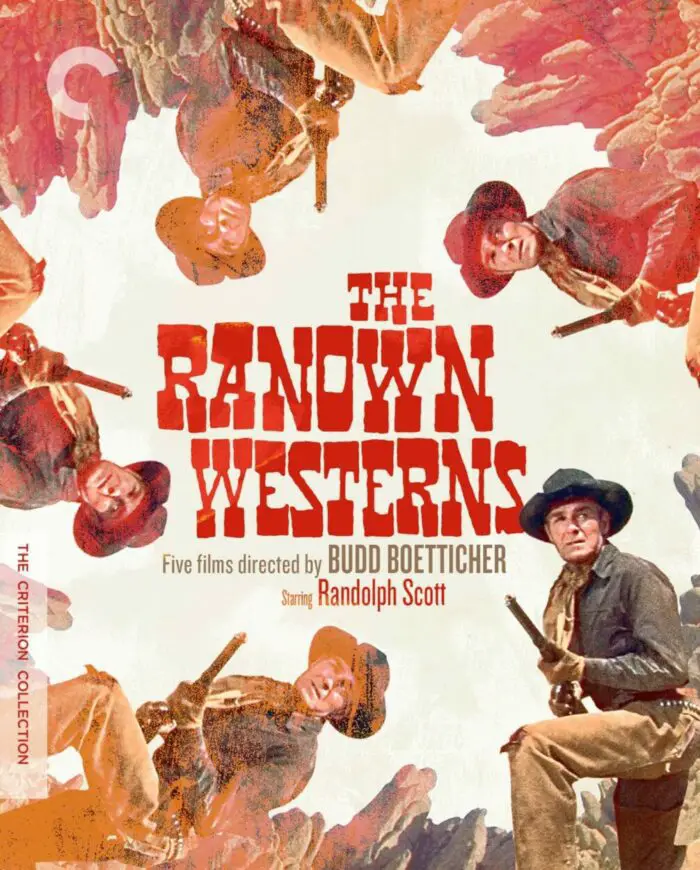
Featuring five full films remastered on 4K (and Blu-ray) and a bonus disc of supplements in a handsome package retailing for $149.95, The Ranown Westerns offers up a week’s worth of bristling, prickly performances and behind-the-scenes nuggets, more than enough to satisfy any cinephile or collector, especially if you score one of the Criterion Collection’s biannual 50% off sales. Here’s the lowdown on each of the individual films and the box set’s special features.
The Tall T (1957)
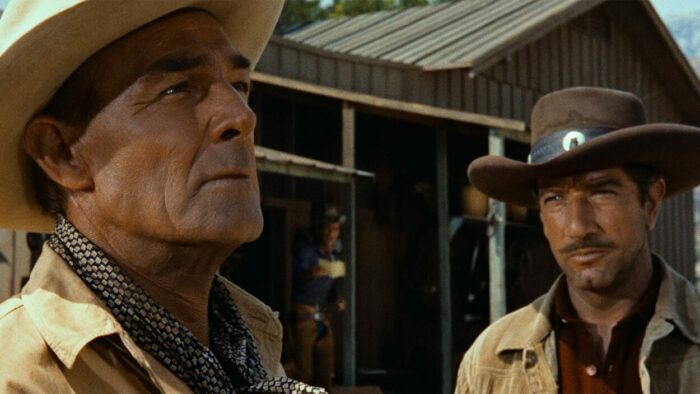
The first film in the set, 1957’s The Tall T, opens with a trope that will become familiar throughout the series: Randolph Scott, riding tall in the saddle, about to find himself confronted with a formidable evil. None of these films take excessive narrative risks nor aim to undermine the genre’s most established tropes, rather, the Ranown Westerns exploit fully all the pleasures and pathos the genre has to offer. The Tall T, based on a story by Elmore Leonard, is a masterclass in the economy of causal storytelling, plunging viewers into a conflict between Scott’s easygoing rancher and an equally compelling villain, Richard Boone’s charming, at times even almost sympathetic villain Frank Usher. Maureen O’Sullivan plays the the newlywed daughter of a wealthy mining baron, saddled with a schlump of a husband (John Hubbard) whose husband is happy to use her as a hostage. Scott’s Pat Brennan is no innocent himself, but his experience makes him an expert in playing both sides against the middle to outwit Usher’s band of ruthless stagecoach robbers.
Decision at Sundown (1957)

By the time of the Ranown Westerns, Scott was as known a quality in Hollywood generally and the Western genre specifically as any actor, even a John Wayne or Gary Cooper. Indeed, one might think of either of their war-movie performances, but Randolph Scott was always first and foremost of a Western hero. In Decision at Sundown he subverts his own typically upstanding image, signaling a change in the tenor of these films. Again, Scott is a mysterious stranger, but here he comes with a consumptive hatred and desire for revenge. He arrives in the corrupt town of Sundown hell-bent to kill the man he blames for his wife’s long-ago suicide, but as the plot progresses his motivations become clouded. The town is corrupt, no question; but is he—our upstanding, progressive, handsome hero—equally compromised? Even as his presence upends the town’s self-satisfied, corrupt cronyism, his own moral compass is called into question, making Decision at Sundown a film that like the revisionist Westerns to follow in later decades one that challenges the myth of the righteous gunslinger’s taste for vengeance.
Buchanan Rides Alone (1958)
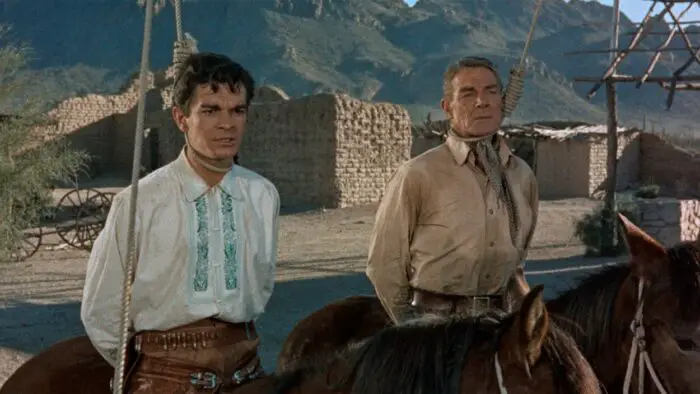
With each of these five films you can see a little more gray in Scott’s mane and a few more age lines crease his visage. At the same time, the films’ settings and themes become by degrees a bit more bleak. If Sundown was a town riddled by corruption, Agry, the setting of Buchanan Rides Alone, is so run rife with corruption it knows nothing else. Two rival brothers—a mayor/judge and a sheriff—preside over a border town so swamped with greed it knows nothing but. Scott plays a drifter, Tom Buchanan who finds himself alongside a young Mexican vaquero railroaded for a murder he witnessed and thrust into violent cesspool of moral decay. At one point he, the vaquero, the brothers, their minions, and most of the townspeople stand armed against each other over two saddlebags full of money, taking up fire against anyone making a claim to it. Buchanan Rides Alone makes for a noir-tinged thriller full of satisfying double-crosses, especially as it draws towards its standoff final sequence.
Ride Lonesome (1959)
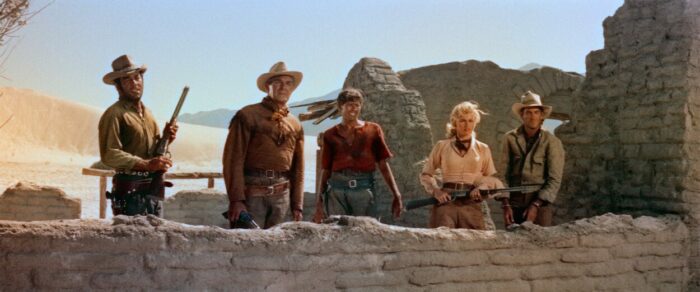
In Ride Lonesome, Scott plays a bounty hunter delivering a captured murderer whose task is complicated when a pair of outlaws horn in on the mission, each of them with their own agendas. Scott is as always front and center, just a little smarter and a little better a man than those around him, but here the supporting cast—including James Coburn in his film debut, Lee Van Cleef, and Pernell Roberts—shine equally. Burt Kennedy’s script offers up a thorny patch of allegiances and betrayals. As the principals gather, including Scott, his captive, and each of the outlaws invested in the outcome, Boettinger again drives the conflicts home with a rousing concluding sequence and in this case, unforgettable imagery. The first film in the series shot in the 2.35 aspect ratio of Cinemascope, Ride Lonesome exploits the format’s potential for visas and arrangements of figures that emphasize the vast lonesomeness of the Old West.
Comanche Station (1960)
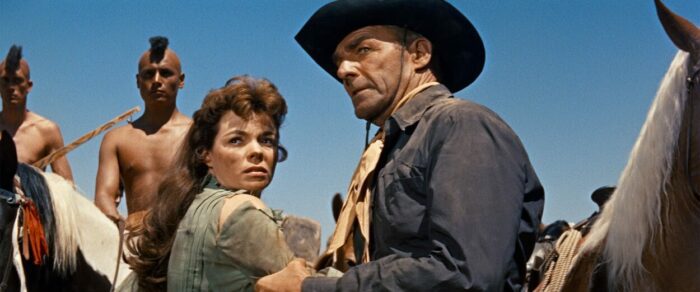
With Comanche Station, the final collaboration between Boetticher and Scott reaches its apex. Scott’s Jefferson Cody rescues a woman kidnapped by Comanches, but this is only the beginning of the story. Boetticher and writer Burt Kennedy’s technique was here, as elsewhere, to tell the “middle” of the story: not the captivity nor the consequence but that brief moment of rescue and return. As it turns out, the Comanche are only one enemy, as a trio of bounty hunters led by the always-charismatic Claude Akin have their own designs on the reward—as well as their own internal conflicts. Kennedy’s tight script lays out each character’s moral dilemma on their way to a surprising but supremely satisfying resolution.
These five films were not the only collaborations between Boetticher and Scott. They first paired up, without Brown, on 1956’s Seven Men from Now and also made Westbound in 1959 between Ride Lonesome and Comanche Station as a contract job for Warner Bros. Nonetheless, these five films make for a fulfilling, cohesive set on their own, charting the penultimate phase of their star’s long career and synthesizing Boetticher’s economical technique and complex thematics. They’ve also been the subject together of a fine limited edition region-free Blu-ray box set known as Five Tall Tales from UK distributor Powerhouse films some years back, replete with special features itself, so this set may not be worth the upgrade solely for the 4K content if you already own that prior one.
These Ranown films were among the last Scott would make. His last film appearance, Ride the High Country, directed by Sam Peckinpah and co-starring Joel McCrea, came in 1962, and became far better known than any of the films in this set, a classic that along with The Man Who Shot Liberty Valance concluded the classic phase of the Western genre. Scott settled into retired life as a wealthy man, and his famously creased, handsome visage became the inspiration for the Oakland Raiders logo. This phase of his career, in collaboration with Boetticher, makes for a satisfying study of the aging gunslinger in an increasingly complex mythos of the American West.
Special Features
The new 4K digital restorations by Sony Pictures Entertainment, with uncompressed monaural soundtracks, are presented on three 4K UHD discs of the films presented in Dolby Vision HDR and three Blu-rays with the films and supplements, packaged in a handsome trifold case with a new cover by F. Ron Miller and a booklet featuring excellent essays by film scholar Tom Gunning on the film’s themes and productions and critic Glenn Kenny on the films’ finely drawn antagonists.
The film discs present each remastered film with English subtitles for the deaf and hard of hearing. Excellent audio commentaries, all recorded for a 2008 DVD package, are available for The Tall T by always-welcome film scholar Jeanne Basinger; for Ride Lonesome by historian Jeremy Arnold; and for Comanche Station by Taylor Hackford. Would it be too much to commission new commentary tracks for the remastered Decision at Sundown or Buchanan Rides Alone? I would imagine there would be no shortage of critics available to lend their talents to such a task. Last, the Blu-ray disc for Comanche Station includes a 20-minute Super 8 version of the film with an egregious voice-of-God voiceover narration produced by Columbia Pictures in 1973 for home and school use. Just what one of my ninth-grade social studies teachers would have played on a quiet school day then under the pretense of history.
That last featurette is worth comparing to the remastered film, nearly pristine and bright in its color and almost free of grain or artifact, a pleasure to immerse yourself in. If you’ve never seen Comanche Station—or any of the films in this set—in their native aspect ratio or on a professional projection system, the films in this set are bound to please.

The Supplements Blu-ray disc rounds out the boxset’s special features. While only one of these featurettes was commissioned specifically for this new release, all told the featurettes, alongside the commentary tracks, introductions, and alternate versions will provide enthusiasts with more than 10 hours with of solid, entertaining, informative content. Even for the collection’s estimable MSRP, that’s an impressive, immersive package introducing viewers to the unique perspective on the American West laid out by Boetticher and Scott in these prickly, bristling, thought-provoking films. The featurettes include the following:
- “Budd Boetticher: A Man Can Do That,” a 2005 documentary about Boetticher featuring interviews with Quentin Tarantino, Clint Eastwood, Peter Bogdanovich, Taylor Hackford and others. The director, his peers, and admirers discuss his life and career. Richard Harris narrates in English and it runs 84 minutes.
- “Cinema, de notre temps: Boeticher Rides Again,” a 59-minute 1995 episode directed by Claude Ventura and written by Phillipe Garnier, features an extended interview with Boetticher about his career in Hollywood. It is spoken in French and English with English subtitles.
- “Budd Boetticher: A Study in Self-Determination,” an hour-long 1971 documentary in English featuring Taylor Hackford interviewing Boetticher specifically about his experiences as a bullfighter in Mexico.
- “Visiting Budd Boetticher,” a 1999 interview running a little over a half-hour directed by Eckhardt Schmidt with Boetticher focusing on his collaborations with actor Randolph Scott and screenwriter Burt Kennedy in the Ranown cycle.
- “Budd Boetticher and Jim Kitses,” an hour-long 1969 audio interview between the director and the film scholar (Horizons West), also focusing on the Ranown cycle.
- “Farran Smith Nehme on actor Randolph Scott,” a new 25-minute program with the film critic reflecting on the iconography of the veteran actor, from his early days in Hollywood to his collaborations with Boetticher to his swan song, Ride the High Country, but focusing primarily on the Ranown cycle films. The only new content commissioned for this boxset, Nehme’s analysis is supplemented by video clips from the remastered films.
Disclosure: The Criterion Collection provided a complimentary package for review consideration.




